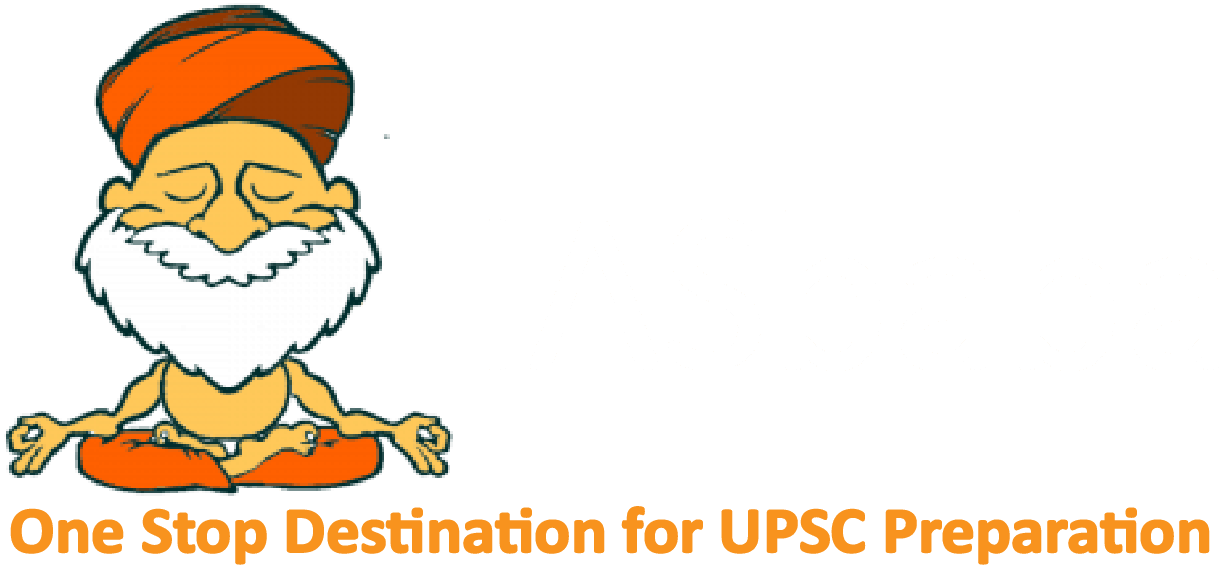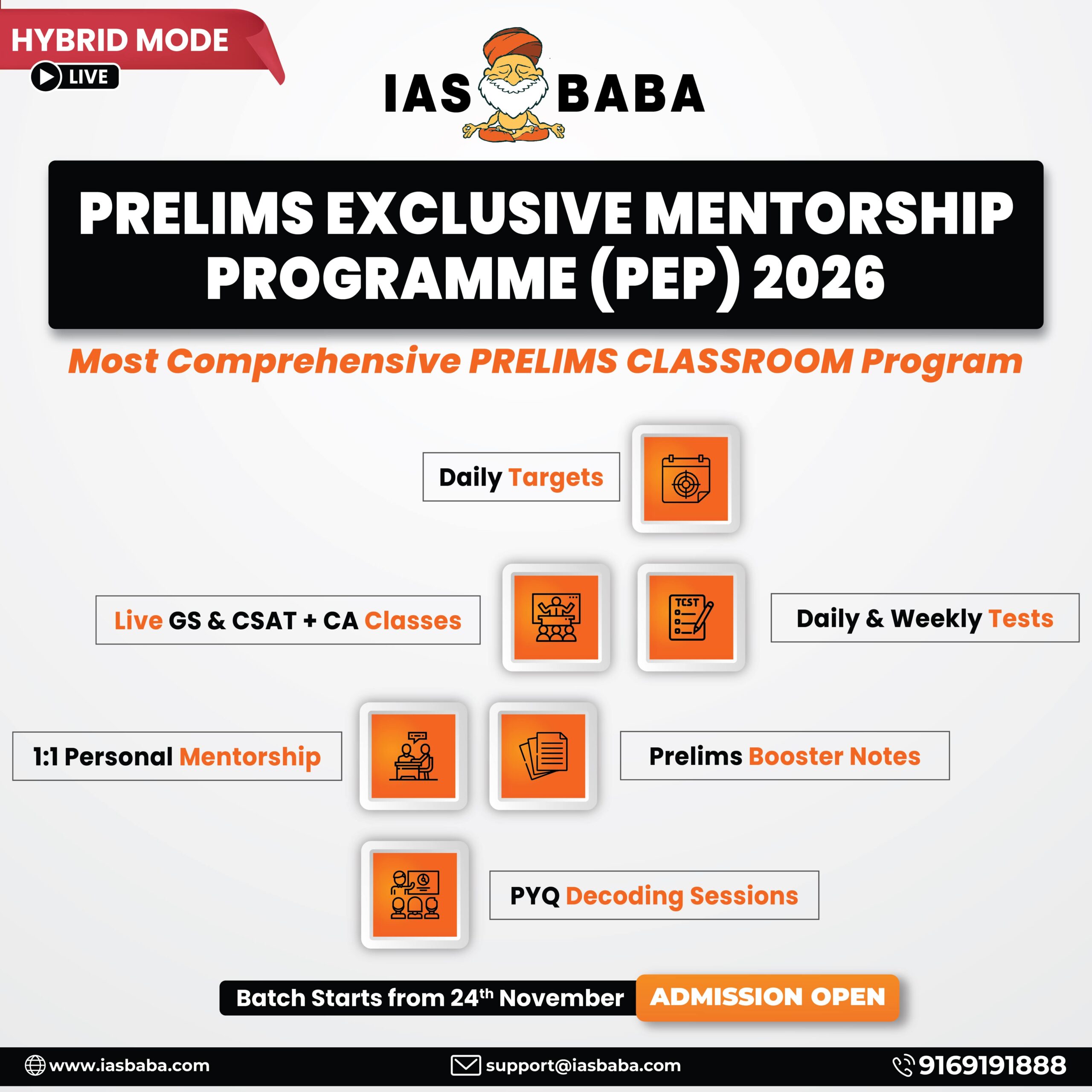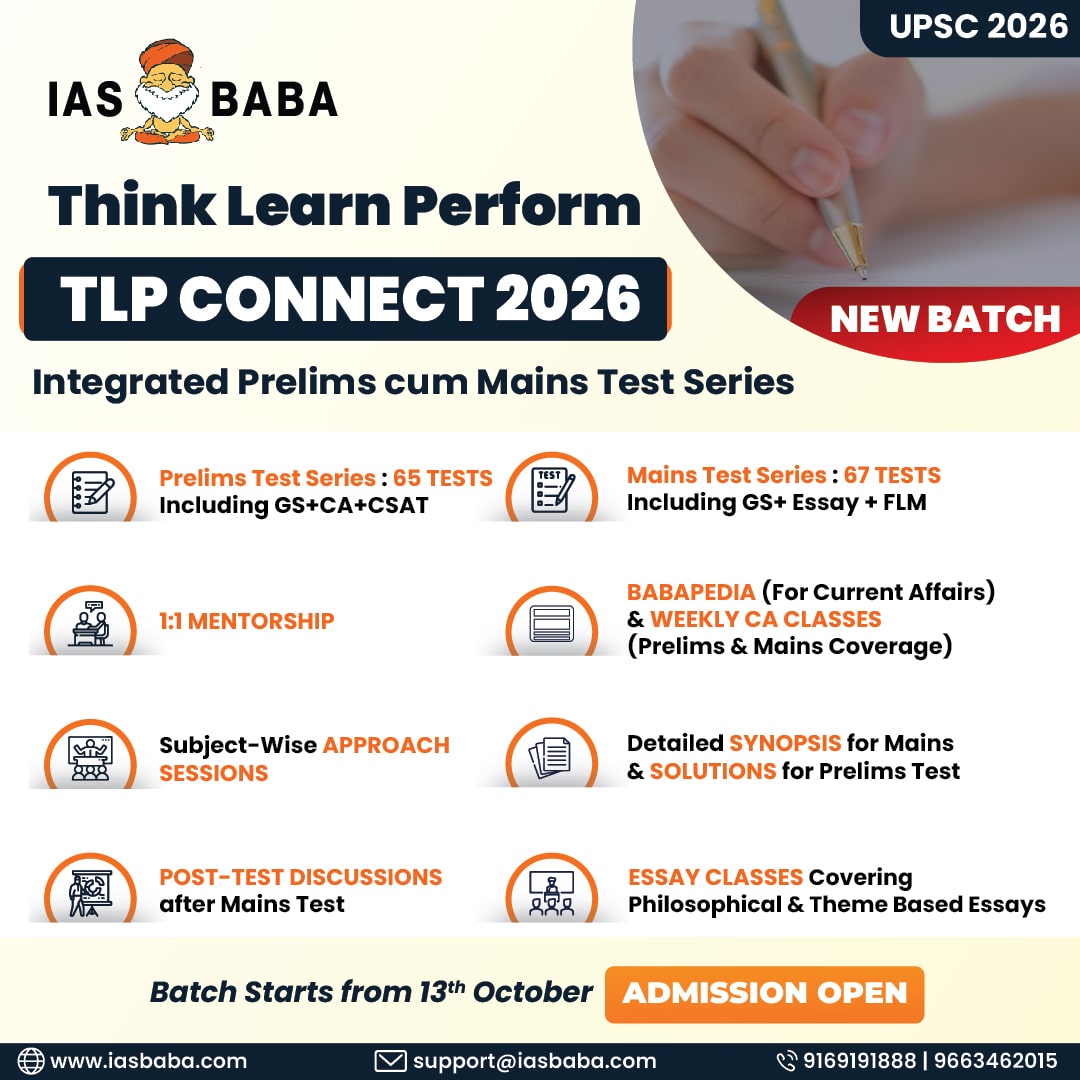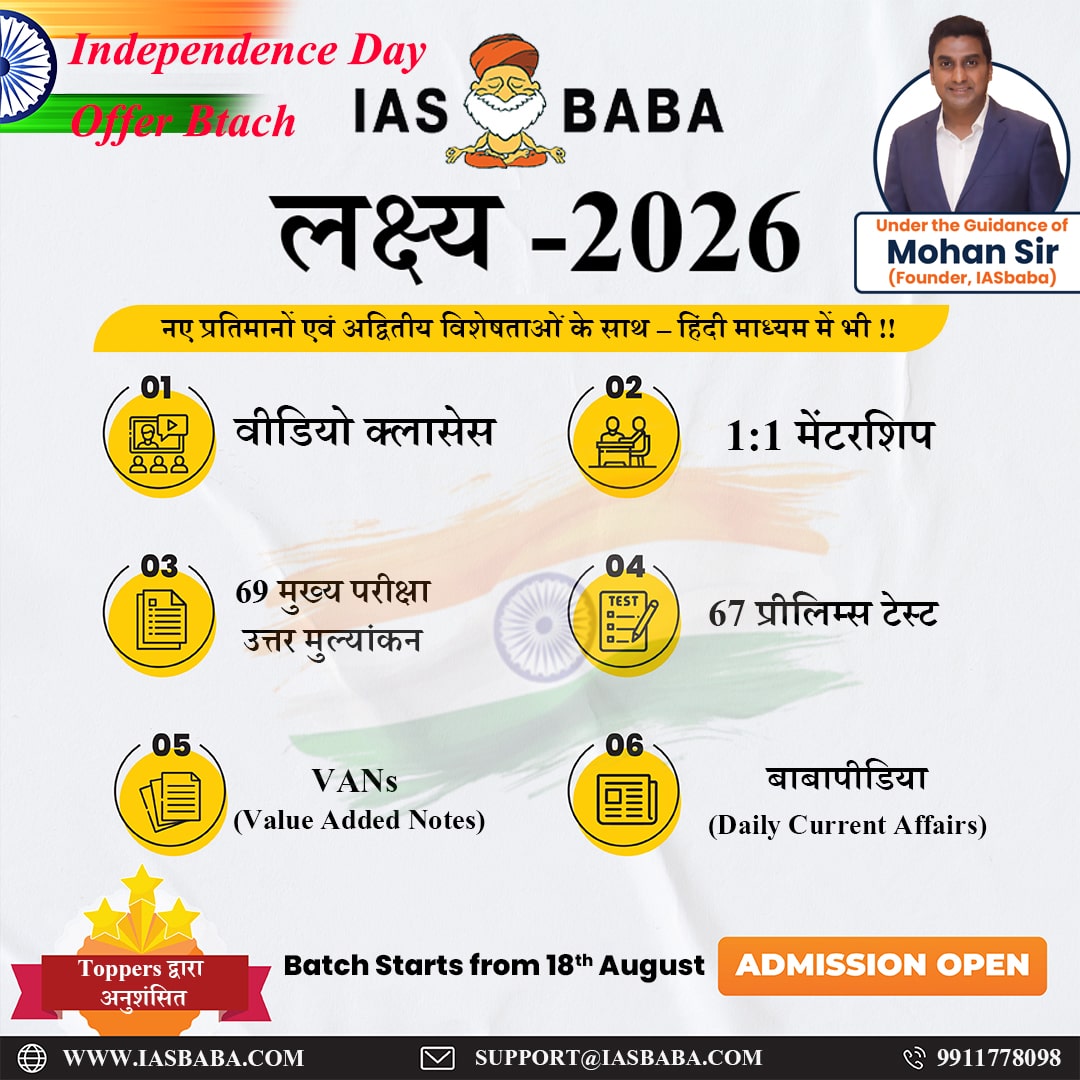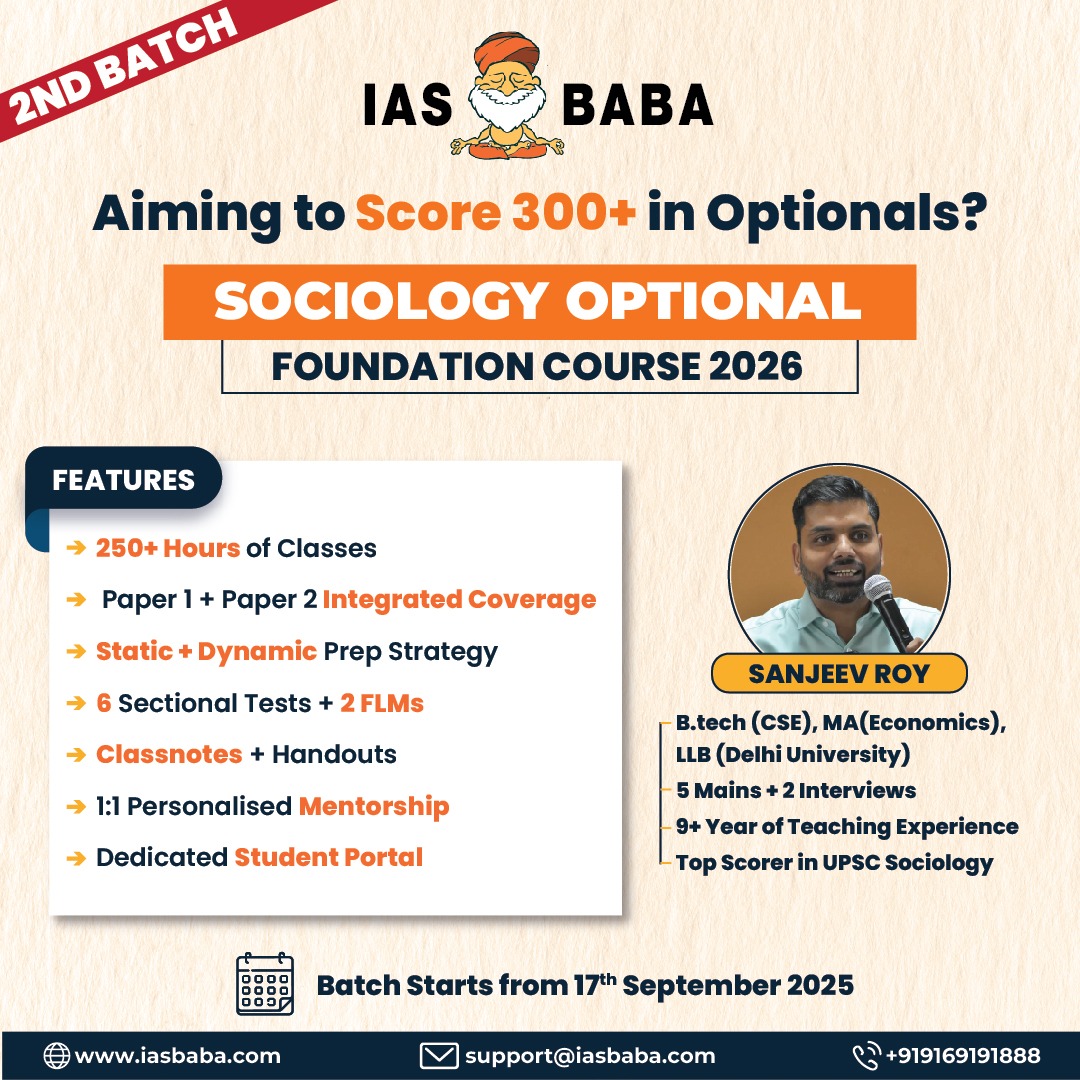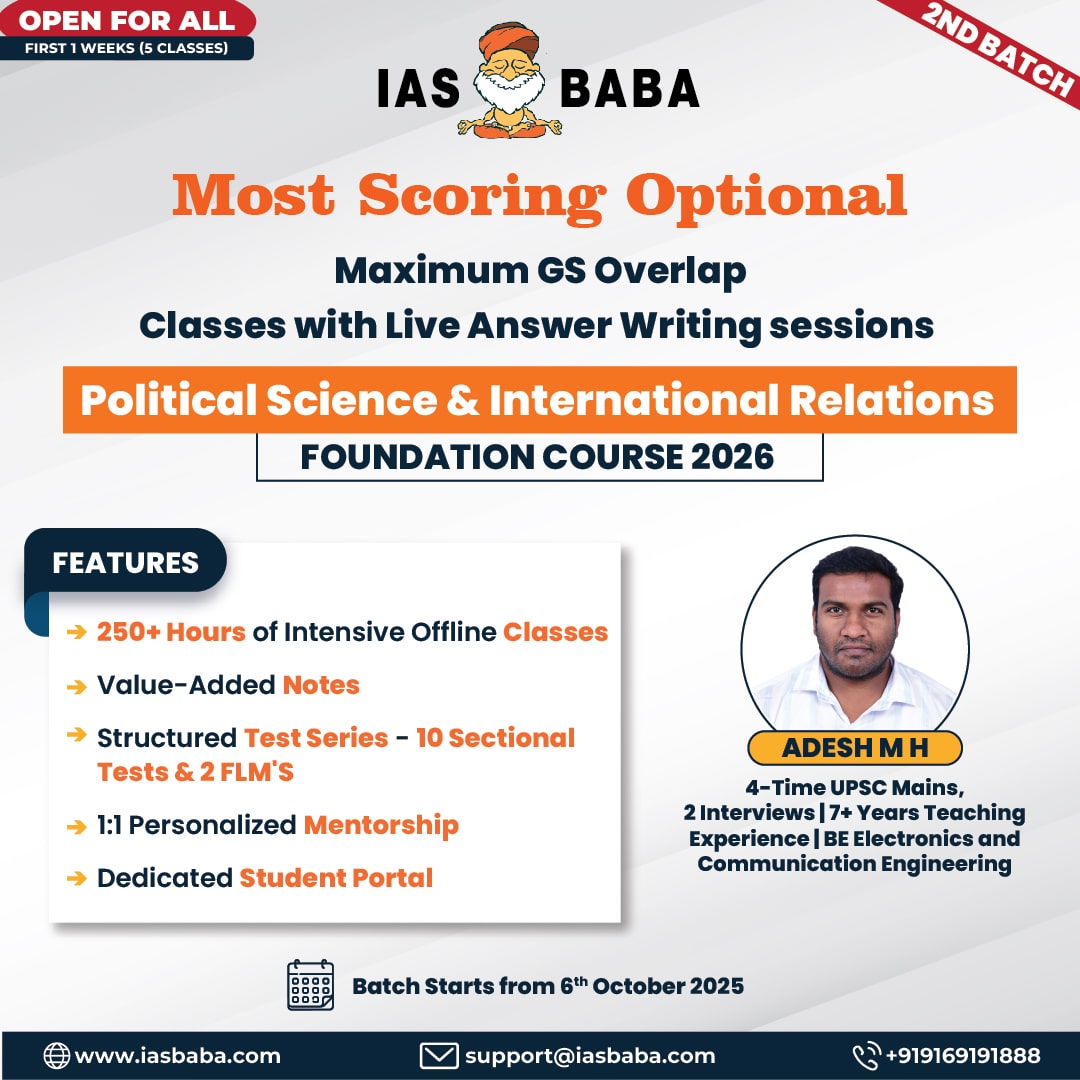IASbaba Daily Prelims Quiz
For Previous Daily Quiz (ARCHIVES) – CLICK HERE
The Current Affairs questions are based on sources like ‘The Hindu’, ‘Indian Express’ and ‘PIB’, which are very important sources for UPSC Prelims Exam. The questions are focused on both the concepts and facts. The topics covered here are generally different from what is being covered under ‘Daily Current Affairs/Daily News Analysis (DNA) and Daily Static Quiz’ to avoid duplication. The questions would be published from Monday to Saturday before 2 PM. One should not spend more than 10 minutes on this initiative.
Gear up and Make the Best Use of this initiative.
Do remember that, “the difference between Ordinary and EXTRA-Ordinary is PRACTICE!!”
Important Note:
- Don’t forget to post your marks in the comment section. Also, let us know if you enjoyed today’s test 🙂
- After completing the 5 questions, click on ‘View Questions’ to check your score, time taken, and solutions.
Test-summary
0 of 5 questions completed
Questions:
- 1
- 2
- 3
- 4
- 5
Information
To view Solutions, follow these instructions:
- Click on – ‘Start Test’ button
- Solve Questions
- Click on ‘Test Summary’ button
- Click on ‘Finish Test’ button
- Now click on ‘View Questions’ button – here you will see solutions and links.
You have already completed the test before. Hence you can not start it again.
Test is loading...
You must sign in or sign up to start the test.
You have to finish following test, to start this test:
Results
0 of 5 questions answered correctly
Your time:
Time has elapsed
You have scored 0 points out of 0 points, (0)
| Average score |
|
| Your score |
|
Categories
- Not categorized 0%
| Pos. | Name | Entered on | Points | Result |
|---|---|---|---|---|
| Table is loading | ||||
| No data available | ||||
- 1
- 2
- 3
- 4
- 5
- Answered
- Review
-
Question 1 of 5
1. Question
- The “Nature’s World Heritage Outlook” report is released by which of the following organizations?
Correct
-
Solution (d)
Explanation:
- The IUCN (International Union for Conservation of Nature) releases the World Heritage Outlook report.
- It assesses the conservation status of natural World Heritage sites globally, focusing on their protection, management effectiveness, and threats such as climate change.
- While UNESCO designates the sites, the IUCN serves as the official advisory body on natural heritage under the World Heritage Convention.
Incorrect
-
Solution (d)
Explanation:
- The IUCN (International Union for Conservation of Nature) releases the World Heritage Outlook report.
- It assesses the conservation status of natural World Heritage sites globally, focusing on their protection, management effectiveness, and threats such as climate change.
- While UNESCO designates the sites, the IUCN serves as the official advisory body on natural heritage under the World Heritage Convention.
-
Question 2 of 5
2. Question
-
With reference to Birsa Munda, consider the following statements:
-
Birsa Munda led the Ulgulan movement against the British and dikus (outsiders) in the region corresponding to the present-day Chotanagpur plateau.
-
The movement aimed at establishing the Munda Raj and restoration of traditional land rights usurped by landlords and moneylenders.
-
The Chotanagpur Tenancy Act of 1908, which restricted the transfer of tribal land to non-tribals, was a direct outcome of the Birsa Munda movement.
How many of the above statements are correct?
Correct
-
Solution (c)
Explanation:
- Birsa Munda mobilized the tribal communities of the Chotanagpur region (now in Jharkhand) against British colonial rule and exploitative outsiders (dikus), including landlords and moneylenders. Hence Statement 1 is Correct
- The Ulgulan (meaning “The Great Tumult”) sought to establish Munda Raj—a return to their ancestral system of self-rule and land ownership. It was both a social and religious movement aiming to reform the community and resist British interference. Hence Statement 2 is Correct
The Chotanagpur Tenancy Act of 1908 was enacted following the uprising. It legally recognized tribal land rights and restricted land transfers from tribals to non-tribals—seen as a direct legacy of Birsa’s movement Hence Statement 3 is Correct
Incorrect
-
Solution (c)
Explanation:
- Birsa Munda mobilized the tribal communities of the Chotanagpur region (now in Jharkhand) against British colonial rule and exploitative outsiders (dikus), including landlords and moneylenders. Hence Statement 1 is Correct
- The Ulgulan (meaning “The Great Tumult”) sought to establish Munda Raj—a return to their ancestral system of self-rule and land ownership. It was both a social and religious movement aiming to reform the community and resist British interference. Hence Statement 2 is Correct
The Chotanagpur Tenancy Act of 1908 was enacted following the uprising. It legally recognized tribal land rights and restricted land transfers from tribals to non-tribals—seen as a direct legacy of Birsa’s movement Hence Statement 3 is Correct
-
-
Question 3 of 5
3. Question
- The Hanle Dark Sky Reserve is located in which of the following regions?
Correct
-
Solution (c)
Explanation:
- The Hanle Dark Sky Reserve lies in the Changthang Plateau near Hanle village in eastern Ladakh, at an altitude of around 4,500 metres.
- It surrounds the Indian Astronomical Observatory, one of the world’s highest sites for optical, infrared, and gamma-ray telescopes.
- Established in 2022, it was jointly developed by the Indian Institute of Astrophysics (IIA), the Ladakh Administration, and the LAHDC, Leh.
- Its dry atmosphere, high altitude, and low light pollution make it comparable to other world-renowned stargazing locations like Atacama (Chile) and Mauna Kea (Hawaii).
Incorrect
-
Solution (c)
Explanation:
- The Hanle Dark Sky Reserve lies in the Changthang Plateau near Hanle village in eastern Ladakh, at an altitude of around 4,500 metres.
- It surrounds the Indian Astronomical Observatory, one of the world’s highest sites for optical, infrared, and gamma-ray telescopes.
- Established in 2022, it was jointly developed by the Indian Institute of Astrophysics (IIA), the Ladakh Administration, and the LAHDC, Leh.
- Its dry atmosphere, high altitude, and low light pollution make it comparable to other world-renowned stargazing locations like Atacama (Chile) and Mauna Kea (Hawaii).
-
Question 4 of 5
4. Question
-
With reference to the Lokpal and Lokayuktas Act, 2013, consider the following statements:
-
The Lokpal consists of a Chairperson and a maximum of eight Members, of which 50% shall be judicial Members.
-
The Chairperson of the Lokpal must necessarily be a serving or former Chief Justice of India.
-
The selection committee for appointing the Lokpal is chaired by the Prime Minister and includes the Leader of Opposition in the Lok Sabha and the Chief Justice of India or his nominee.
How many of the above statements are correct?
Correct
-
Solution (b)
Explanation:
- Under Section 3(2) of the Lokpal and Lokayuktas Act, 2013, the Lokpal consists of a Chairperson and up to eight Members, and 50% of the Members shall be judicial Members. Hence Statement 1 is Correct
- The Chairperson need not be a serving or former Chief Justice of India. He/She can be a former Chief Justice of India, a former Judge of the Supreme Court, or a person of eminence in public affairs with at least 25 years of experience. Hence Statement 2 is Incorrect
- As per Section 4(1), the Selection Committee comprises:
- The Prime Minister (Chairperson),
- The Speaker of the Lok Sabha,
- The Leader of Opposition in the Lok Sabha,
- The Chief Justice of India or a nominee, and
- One eminent jurist nominated by the President.
- Hence Statement 3 is Correct
Incorrect
-
Solution (b)
Explanation:
- Under Section 3(2) of the Lokpal and Lokayuktas Act, 2013, the Lokpal consists of a Chairperson and up to eight Members, and 50% of the Members shall be judicial Members. Hence Statement 1 is Correct
- The Chairperson need not be a serving or former Chief Justice of India. He/She can be a former Chief Justice of India, a former Judge of the Supreme Court, or a person of eminence in public affairs with at least 25 years of experience. Hence Statement 2 is Incorrect
- As per Section 4(1), the Selection Committee comprises:
- The Prime Minister (Chairperson),
- The Speaker of the Lok Sabha,
- The Leader of Opposition in the Lok Sabha,
- The Chief Justice of India or a nominee, and
- One eminent jurist nominated by the President.
- Hence Statement 3 is Correct
-
-
Question 5 of 5
5. Question
-
With reference to the upcoming GSAT-7R satellite, consider the following statements:
-
It is designed to enhance real-time, beyond-line-of-sight communication capabilities for Indian naval assets, replacing the legacy GSAT-7 (Rukmini).
-
Unlike GSAT-7A, which primarily serves the Indian Air Force, GSAT-7R will operate in a sun-synchronous orbit to provide constant coverage over the Indian Ocean Region.
Which of the statements given above is/are incorrect?
Correct
-
Solution (b)
Explanation:
- GSAT-7R is a dedicated military communication satellite being developed by ISRO for the Indian Navy. It will replace GSAT-7 (Rukmini) and strengthen secure, real-time, beyond-line-of-sight communication links for naval ships, aircraft, and submarines across the Indian Ocean Region. Hence Statement 1 is Correct
- GSAT-7R will be placed in a geostationary orbit, not a sun-synchronous orbit.
- Geostationary orbit (GEO) allows continuous coverage over a fixed region — ideal for maritime communication.
Sun-synchronous orbit (SSO) is used for Earth-observation and surveillance satellites, not for communication purposes. Hence Statement 2 is Incorrect
Incorrect
-
Solution (b)
Explanation:
- GSAT-7R is a dedicated military communication satellite being developed by ISRO for the Indian Navy. It will replace GSAT-7 (Rukmini) and strengthen secure, real-time, beyond-line-of-sight communication links for naval ships, aircraft, and submarines across the Indian Ocean Region. Hence Statement 1 is Correct
- GSAT-7R will be placed in a geostationary orbit, not a sun-synchronous orbit.
- Geostationary orbit (GEO) allows continuous coverage over a fixed region — ideal for maritime communication.
Sun-synchronous orbit (SSO) is used for Earth-observation and surveillance satellites, not for communication purposes. Hence Statement 2 is Incorrect
-
- Current Affairs Quiz, IAS Daily Current Affairs Quiz, IAS UPSC Current Affairs Quiz, IAS UPSC Prelims Quiz, IASbaba's Current Affairs Prelims Quiz, IASbaba's Daily Quiz, IASbaba's UPSC Quiz, Prelims Current Affairs Quiz, UPSC Current Affairs Quiz, UPSC Current Affairs Quiz IASbaba, UPSC Daily Current Affair Quiz, UPSC IAS Daily Quiz

